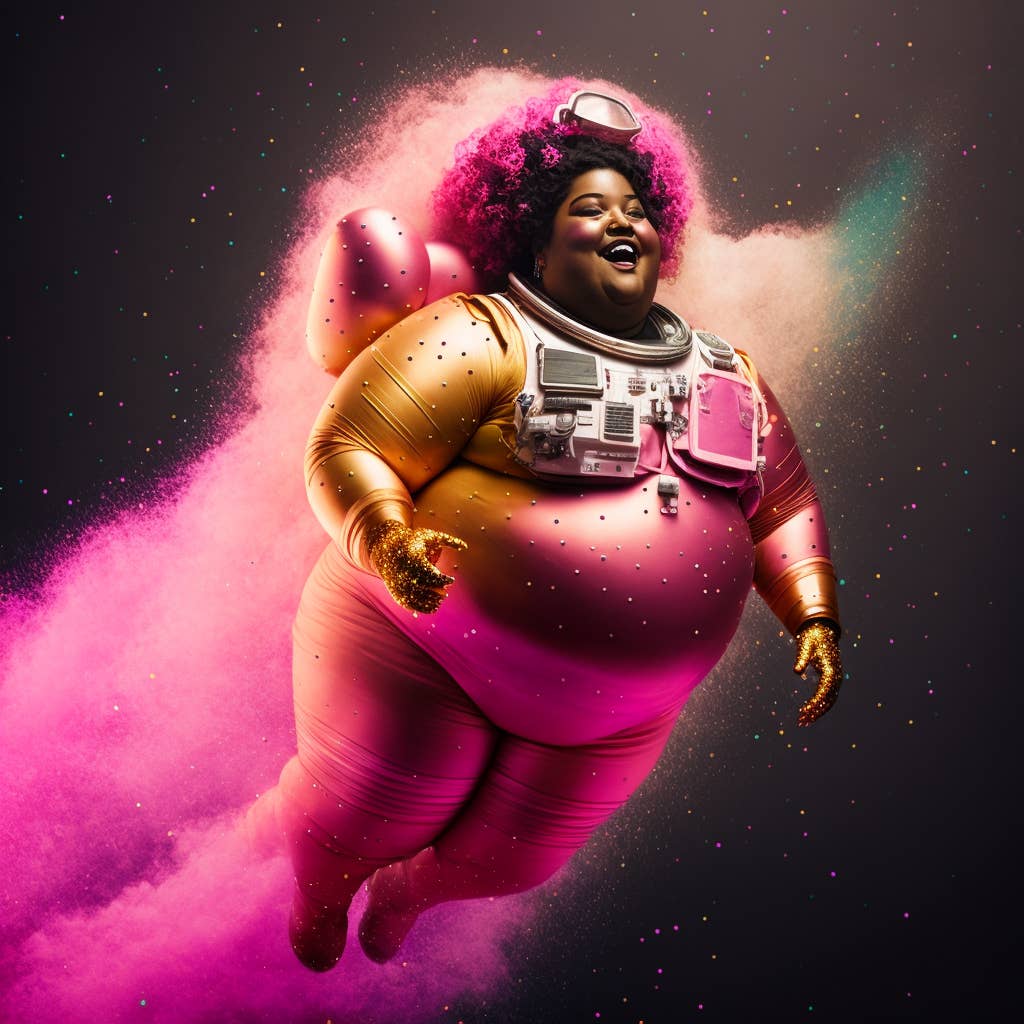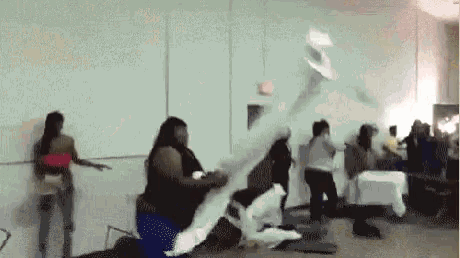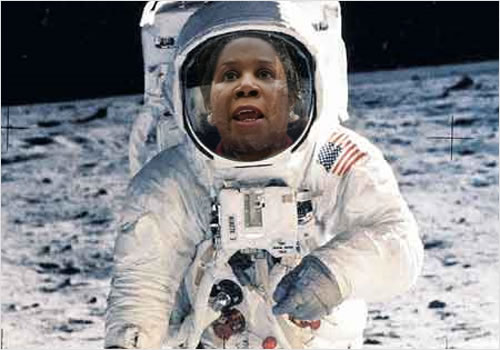Fortunately AI is coming to the rescue!
Links and images at the source.

Posted on 02/26/2023 7:44:55 AM PST by Drew68
“Fat, Black people deserve to be main characters capable of anything.”
As a young child growing up in Greenville, North Carolina, artist Alex Smith spent a lot of his time engrossed in the world of cartoons and comics, devouring works like Battle of the Planets, X-Men, and Doom Patrol.
In college, Smith first encountered science fiction novels by Octavia E. Butler and Samuel R. Delany, both of whom he admired because “they were Black and absolutely, phenomenally awesome.”
“They both showed me that sci-fi could have literary quality, could be progressive and liberatory,” Smith added. “Just their ideas, world-building, and love of language fascinated me.”
He was hooked. “Sci-fi is kinda like my church,” said Smith, who is now age 47 and living in Philadelphia. “It’s spiritual and very much connected to who I am as a Black, queer person.” The problem with his church, however, is that there isn’t very much Black (or queer) representation.
Mainstream sci-fi features Black characters like Morpheus from The Matrix, Mace Windu from Star Wars, and Lt. Commander La Forge and Nyota Uhura from Star Trek. But in general, Black characters aren’t afforded the same prominence and screentime as their white counterparts. And when Black people are present, they tend to be cishet assumed and conventionally attractive. Fat, Black bodies are a rarity.
“It just astonishes me that fat people in general are treated and depicted as second-class citizens in science fiction works, or they're made to represent something like greed, lust, or villainy,” Smith said, pointing to the character of Baron Vladimir Harkonnen in Dune.undefinedundefined“I used to do a queer sci-fi reading series called Laser Life,” he added, “and when I was on the hunt for guest readers, the very first story I received depicted a villain who was fat. The character's fatness was described in loathsome terms and was considered an obvious indicator of their villainy. It’s really disappointing.”
So when easily accessible AI art generators came along last year, Smith, already an established visual artist, adopted these tools to create several Black, fat, and queer characters from a more inclusive futuristic world. Among them was Marcus, whom Smith brought to life using Midjourney and D-ID, an AI platform that creates talking avatars. Marcus heads up a division of the Electric Afro Science Institute, which Smith called “a superhero-led independent afrofuturist organization that works in biomechanics, cosmic engineering, nanotechnology, medical alchemy.”
Smith described Marcus, who is queer, as “kind of a smart alec. A big, cuddly nerd who thinks he’s a little bit gangster. He likes studying moths and ants and tries to see what about the lives of insects can be replicable in human life.” In one animated portrait of Marcus, which Smith posted on his Instagram, the character asks, “Who out here gonna draw me?”
“[The question is] Marcus saying, Hey, I have a right to exist, even if I’m “artificial.” I still came from a human mind and a human idea. I should exist,” Smith explained. He added, “It’s kind of a declaration that both Marcus and my work will always exist to provide that challenge to other artists by holding up a mirror and saying, ‘Hey, this is what your worlds are lacking.’”
Smith is not alone in holding up that mirror. A number of other Black creators are using AI to build more inclusive worlds. Take Jervae, a 38-year-old, San Diego–based performance artist and spiritualist who uses Midjourney to make ethereal portraits of themself and other fat, Black femmes. “When using my own image prompts, I use descriptors like ‘imagine this image as a body of water’ or ‘imagine this as a poster for an alien nail salon’ to explore different versions of myself,” they said.
Rochelle Brock, a 27-year-old Brooklyn-based, size-inclusive beauty and lifestyle photographer, got into digital art via creating families on The Sims. Now, she uses Midjourney to explore both the quotidian aspects of fat, Black life and to create more majestic pieces that showcase fat, Black bodies in the form of angels, mermaids, and other mythical creatures.
“It sort of sucks to know you are undesirable and underrepresented in the real world and the fantasy world as well,” Brock said. “I see fat women as beautiful beings who are capable of anything, and I wanted AI to see them as that also.”
And then there’s @fatniggaai, a 33-year-old North Carolina artist who asked that BuzzFeed News not use her real name. @fatniggaai describes her AI art as a visual ode to “those who are fat, Black, dark-skinned, queer, trans, working-class poor, who access education outside of institutions, who are crazy/mad and who are hood.” They largely use Midjourney to create their art, which ranges from the “playful” and “unthinkably gorgeous” to the more terrifying.
“My AI work is an extension of me inviting myself and other fat, Black queer trans folks to see ourselves in the most expansive way possible,” said @fatniggaai, who added that she wasn’t particularly into sci-fi, but appreciated the worldbuilding aspect of it. “What I'm really interested in with my AI art is depictions of fat, Black queer and trans folks that are rooted in not being beautiful but rooted in being terrifying and looking very off-putting while also spilling over with agency.”
The latest AI art generators “democratize art by giving people access to programs that are fairly low cost,” Susan Morris, a writer and professor at Georgia Tech, told BuzzFeed News. But when it comes to creating fat, Black renders, there are a number of obstacles.
Jervae noted that they have to be as specific as possible when using keywords pertaining to fatness and Blackness. “When I first started recreating myself in Midjourney, I realized that I couldn’t just put in the word ‘fat.’ I have to write things like ‘very, very fat, with a double chin and wide nose’ and ‘a very, very large belly,’” they said. “If I say anything like ‘beautiful’ or ‘pretty,’ it automatically makes me thin and/or have eurocentric features.”
And there are other hindrances. “Midjourney won’t let me say things like ‘big butt’ or upload images with any cleavage whatsoever,” Jervae said. “But I do notice that thin models, of course, can show whatever they like in their prompts without being flagged.” @fatniggaai said that prompts like “intersex” and, at some point, even “hairy” were banned.
@fatniggaai pointed out other limitations. She recalled trying to generate images of fat, Black people lounging on couches. “I even added words like ‘spacious,’ but the couches were vacuum-sealed onto these fat bodies.” She called it “wild” that a “machine that has access to every image in the world ever produced is so restrictive in its imaginative capacity that it has decided that if a person is fat, and they are sitting on a couch, that they should be too big for it.”
“That blew my mind that I have to ask AI for accommodations,” they added.
On the other hand, AI can be surprisingly good when it comes to skin tones for fat, Black bodies. “The images I generate are almost exclusively of dark-skinned folks, and a benevolent byproduct of racism is that AI has only considered Black, fat people as dark-skinned,” @fatniggaai said.
As imperfect and rooted in white supremacy as AI image generators may be, the artists BuzzFeed News spoke to saw them as important tools for self-expression and proper representation. Smith pointed out why his AI-generated character Marcus is important: “He’s more crush material for burgeoning young queer boys who might think there isn’t a person out there who looks like them or who they can fall in love with.”
For Brock, the message of her artwork is clear and simple. “Fat, Black people deserve to be main characters capable of anything,” she said. “We are just here like everyone else.”
Fortunately AI is coming to the rescue!
Links and images at the source.

Please. I was eating.

> “Fat, Black people deserve to be main characters capable of anything.”
Except losing weight.
“Fat, Black people deserve to be main characters capable of anything,”
Well, that most certainly qualifies as fantasy.....AND comedy as well for that matter.
We’re going to need a bigger oxygen tank!!
This kind of racist nonsense only prolongs racism. And being fat isn’t good for anyone.
‘Stacy in Space’...LOL!
Truly our most valuable resource. I’ve been thinking that the real way to get to Mars really fast is to publicly state that the first person to step off the lander needs to be a disabled obese lesbian of color.
Freegards

Wut? Somebody ate the last piece of fried chicken?
He was hooked. “Sci-fi is kinda like my church,” said Smith, who is now age 47 and living in Philadelphia. “It’s spiritual and very much connected to who I am as a Black, queer person.” The problem with his church, however, is that there isn’t very much Black (or queer) representation.
Food fight good.
Table fight bad.
If an “artist” is using AI, it implies a lack of natural intelligence.

What are they going to do, force people to buy that crap? Or force studios to take huge losses in making these kinds of projects?
Queer is way way overrepresented.
As for fat and black and queer: someone should do a picture of the Blob in blackface and in drag. He could obviously displeased and be saying: “Someone is gonna die for this ignominy!”


Disclaimer: Opinions posted on Free Republic are those of the individual posters and do not necessarily represent the opinion of Free Republic or its management. All materials posted herein are protected by copyright law and the exemption for fair use of copyrighted works.